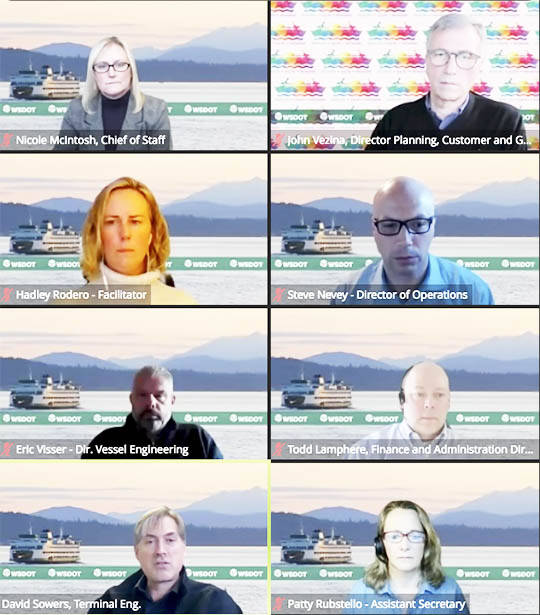This fall, one of the ferries that serves Bainbridge will be converted to hybrid-electric, with the goal to have it in service by 2024.
That was one of the announcements made at the Washington State Ferries online Community Meeting Jan. 11.
The conversion of the Wentachee, which goes from BI to Seattle, is part of $1.12 billion that will be spent over the next 10 years to electrify the ferry system, WSF finance director Todd Lamphere said. About $46 million will be spent on that in the 2023-25 budget, with another $74 million to convert three jumbo vessels, $202.4 million to preserve and maintain current ferries and $21.5 million for personnel.
Lamphere said the investments are crucial as transportation accounts for almost 50% of all greenhouse gas emissions.
Patty Rubstello, WSF assistant secretary, added the overhaul is needed to improve air quality, and Gov. Jay Inslee and the state legislature are showing continued support with funding.
David Sowers, terminal engineer, added WSF is in the early conversations of developing charging stations at terminals for vehicles waiting for ferries. “That would make sense,” he said.
Improving customer service was discussed at the meeting. A lack of vessels and employees has meant a number of cancellations of ferry trips since COVID first hit in early 2020.
Rubstello said many Baby Boomers have been retiring, and it takes a long time to train new employees. Employees missing work and quitting during COVID added to the problem. And before the last legislative session WSF funding had not been a priority, she said.
Ferries get extra busy in summers, and she hopes to have enough employees trained to have a consistent, reliable, normal schedule.
Nichole McIntosh, chief of staff, said WSF is almost continuously hiring, but newcomers start at the ground level, and it takes a while to move up the ranks. Rubstello said even those starting out make good money. But “customer service is not where we want it to be,” she said.
WSF hired 233 new workers last year, and 50 experienced ones are in training seeking promotions. She added when people are promoted that depletes the lower ranks.
The hardest positions to fill are licensed deck officers. They usually just can’t be hired because it takes five years or more to get the experience, training and credentials to become one. “We get a handful a year, and that’s not nearly enough,” Rubstello said.
Other travel options, the number of people served, and more are factors used in deciding which routes to restore first. Bainbridge is second on the list with Kingston fourth, Southworth fifth and Bremerton sixth.
John Vezina, director of planning and customer service, said the San Juans are No. 1 because they have no other travel options. “We are their only highway” for medical and other essential travel, he said, adding, “It’s no fun being lower down on the list.”
Along with a lack of workers, ferry availability also is in crisis. Rubstello said 19 ferries are needed in summer and 17 in winter. There are 21 ferries in the fleet. Scheduled maintenance takes out two ferries at a time during peak season, and four during off-peak times. That does not take into account unscheduled repairs of ferries that put them out of commission for various lengths of time. Two are at that status now, she said.
What makes it even more troublesome is three ferries should be retired now due to age and use, Rubstello said, but because of the shortage, WSF is going to spend millions of dollars to keep them seaworthy.



